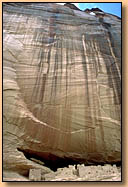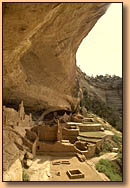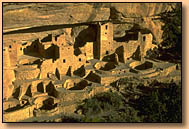
|

|
|
"Somewhere down in the underworld we were created by the Great Spirit, the Creator... We were created equal, of oneness, living in a spiritual way, where the life is everlasting. We were happy and at peace with our fellow men. All things were plentiful, provided by our Mother Earth upon which we were placed." So begins a Hopi account of the beginning of life. |
|
Trees were planted from seeds but even their stoutest branches couldn't penetrate the barrier from the underworld. "Again they planted a seed. This time it was a reed. Since it had a pointed end it pierced the sky into the new world."
Some say that this place of emerging, called the shipapu., was in Kutz Canyon in northwestern New Mexico. And there's no denying that the ancient Anasazi left a road thirty feet wide and as straight as an arrow between a point on the rim of this canyon and their impressive Pueblo Bonito in Chaco Canyon, over thirty miles away. |
|
Led by John Stein of the Navajo Nation, scholars are perceiving how the roads might have linked impressive Pueblo-style buildings with previous Great Houses, bridging the intervening time. The great enigma of the abandonment of the Four Corners area by the Chacoan peoples around the year 1280 comes into clearer focus in connection with these spiritual corridors.
The great Chacoan site of Pueblo Bonito flourished and then was deserted, perhaps owing to drought. Around the same time, a new regional center was established at Aztec Ruins 55 miles due north. North is a sacred direction to descendents of the Anasazi. The Great North Road that runs from Pueblo Bonito to the edge of Kutz Canyon may once have continued on to Aztec Ruins, conveying spiritual energy to the new site along the sacred meridian. |
| And when Aztec Ruins itself was abandoned, a new center was born at Casas Grandes, just over the present border with Mexico, 450 miles due south of Aztec Ruins. Chacoan engineers clearly had the ability to survey straight lines over great distances; their surviving "roads" prove it. |


